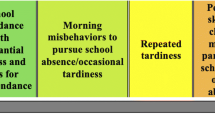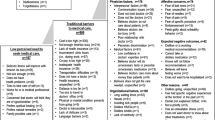Abstract
The objective of this study is to report the findings of a 7-month pilot for an integrated system evaluating a state-wide home visiting program. A cross-sectional study design was used to determine baseline process and outcome measures for Tennessee’s home visiting program which provides services to families, from pregnancy through 5-years-old. Baseline process measures included: time to initiate service after referral; frequency, duration and intensity of visits; completion of continuous assessment; and time from identification of a need to referral. The baseline outcome measures included: needs of eligible services (e.g. developmental screenings, WIC); prenatal care utilization; biological risks (prematurity; low birth weight); tobacco use and second-hand smoke exposure; and family planning utilization. During the pilot, 3,794 families were enrolled, representing 68% (± 1.5%) of incoming referrals. Enrollment dropped from 82% (90 days) to 69% (120 days); 52% of the families received a visit every month. Ninety percent of families had at least one full assessment after enrollment; 60% occurred within the first 60 days. Over 92% of outgoing referrals were made within 7 days. Immunization status (70%) is below the state level (80.8%). A quarter of the infants enrolled in the program are low birth weight and premature (state level 9.2%). Current tobacco use by the prenatal population is 16% compared to the state, 19.7%. The HUGS program serves high risk/high need clients and is consistent with other national home visiting models that have shown higher levels of attrition and lower levels of visits than intended by the model.



Similar content being viewed by others
Notes
Citation is companion paper by same authors and submitted as a separate paper along with this paper.
References
America’s Health Rankings: Tennessee. [website] (2009). Date Accessed: 08/22/2010; Available from: http://www.americashealthrankings.org/yearcompare/2008/2009/TN.aspx.
Kids Count: The State of the Child in Tennessee. Tennessee Commission on Children and Youth. (2009). State of Tennessee: Nashville, TN. Accessed: 10/15/2010. Available from: http://www.tn.gov/tccy/kc.shtml.
Olds, D. L., Henderson, C. R., Jr., Kitzman, H. J., Eckenrode, J. J., Cole, R. E., & Tatelbaum, R. C. (1999). Prenatal and infancy home visitation by nurses: Recent findings. Future Child, 9(1), 44–65, 190–191.
Kitzman, H., Olds, D. L., Sidora, K., Henderson, C. R., Jr, Hanks, C., Cole, R., et al. (2000). Enduring effects of nurse home visitation on maternal life course: A 3-year follow-up of a randomized trial. JAMA, 283(15), 1983–1989.
Olds, D., Henderson, C. R., Jr, Cole, R., Eckenrode, J., Kitzman, H., Luckey, D., et al. (1998). Long-term effects of nurse home visitation on children’s criminal and antisocial behavior: 15-year follow-up of a randomized controlled trial. JAMA, 280(14), 1238–1244.
Olds, D. L., Eckenrode, J., Henderson, C. R., Kitzman, H., Powers, J., Cole, R., et al. (1997). Long-term effects of home visitation on maternal life course and child abuse and neglect. Fifteen-year follow-up of a randomized trial. JAMA, 278(8), 637–643.
Olds, D. L., Kitzman, H., Cole, R., Robinson, J., Sidora, K., Luckey, D. W. et al. (2004). Effects of nurse home-visiting on maternal life course and child development: age 6 follow-up results of a randomized trial. Pediatrics, 114(6), 1550–1559. doi:10.1542/peds.2004-0962, 10.1542/peds.2004-0962.
Olds, D. L., Kitzman, H., Hanks, C., Cole, R., Anson, E., Sidora-Arcoleo, K., et al. (2007). Effects of nurse home visiting on maternal and child functioning: Age-9 follow-up of a randomized trial. Pediatrics, 120(4), e832–e845. doi:10.1542/peds.2006-2111, 10.1542/peds.2006-2111.
Stoltzfus, E. & Lynch, K. (2009). Home Visitation for Families with Young Children, in CRS Report for Congress. Congressional Research Service, pp. 1–55. Accessed: 09/01/2010. Available from: www.crs.gov.
Sweet, M. A., & Appelbaum, M. I. (2004). Is home visiting an effective strategy? A meta-analytic review of home visiting programs for families with young children. Child Development, 75(5), 1435–1456.
Duggan, A., Windham, A., McFarlane, E., Fuddy, L., Rohde, C., Buchbinder, S., et al. (2000). Hawaii’s healthy start program of home visiting for at-risk families: Evaluation of family identification, family engagement, and service delivery. Pediatrics, 105(1 Pt 3), 250–259.
Johnson, K. (2009). State-based home visiting: Strengthening Programs through State Leadership. National Center for Children in Poverty, Mailman School of Public Health, Columbia University: New York, NY. Accessed October 3, 2010. Available from: http://www.nccp.org/publications/pdf/text_862.pdf.
Centers for Disease Control and Prevention (CDC). (2010). Pregnancy risks assessment monitoring system. U.S. Department of Health and Human Services, Centers for Disease Control and Prevention: Atlanta, GA. Accessed October 15, 2010. Available from: http://www.cdc.gov/prams/index.htm and http://www.cdc.gov/prams/Questionnaire.htm.
Centers for Disease Control and Prevention (CDC). (2010). Behavioral Risk Factor Surveillance System (BRFSS) Survey Questionnaire. U.S. Department of Health and Human Services, Centers for Disease Control and Prevention: Atlanta, GA. Accessed October 15, 2010. Available from: http://www.cdc.gov/brfss/questionnaires/index.htm.
Centers for Disease Control and Prevention (CDC). (2010). Behavioral risk factor surveillance system survey data. U.S. Department of Health and Human Services, Centers for Disease Control and Prevention: Atlanta, GA. Accessed October 15, 2010. Available from: http://www.cdc.gov/brfss/technical_infodata/surveydata.htm.
Centers for Disease Control and Prevention (CDC). (2010). 2009 Youth Risk Behavior Survey. U.S. Department of Health and Human Services, Centers for Disease Control and Prevention: Atlanta, GA. Accessed October 20, 2010. Available from: www.cdc.gov/yrbss.
Tennessee Department of Health (TDOH). Vital Records System, State of Tennessee, Tennessee Department of Health: Nashville, TN.
Tennessee Department of Health. (2010). Tennessee Home Visiting Annual Report: July 1, 2008–June 30, 2009. State of Tennessee: Nashville, TN. Accessed: 09/23/2010. Available from: http://health.state.tn.us/Downloads/Home%20Visiting%20Report%20FY%202009.FINAL.pdf.
Jacobs, F. H., Kapuscik, J. L., Williams, P. H., & Kates, E. (2000). Making it count: Evaluating family preservation services. A guide for state administrators (p. 400). Medford, MA: Tufts University. Family Preservation Evaluation Project.
Tennessee Department of Health (TDOH) Communicable and Environmental Disease Services (CEDS). (2009). Immunization status survey of 24-month-old children in Tennessee. State of Tennessee: Nashville, TN. Accessed October 20, 2010. Available from: http://health.state.tn.us/Ceds/PDFs/ImmunizationSurvey2009.pdf.
Tennessee Department of Health. Office of Policy Planning and Assessment (PPA). (2008). Tennessee Pregnancy Risk Assessment Monitoring System Summary Report 2008. State of Tennessee. Tennessee Department of Health.: Nashville, TN. Accessed October 26, 2010. Available from: http://hit.state.tn.us/Reports/HealthResearch/2008%20TN%20PRAMS%20Report.pdf.
The Patient Protection and Affordable Care Act (PPACA). (2010). (Public Law 111-148; 124 Stat. 119). 111th United States Congress.
Coalition for Evidence-Based Policy. (2006). Which study designs can produce rigorous evidence of program effectiveness? A brief overview. In Coalition for evidence-based policy working paper. Washington, DC: Coalition for Evidence-Based Policy. Accessed October 4, 2010. Available from: http://evidencebasedpolicy.org/docs/RCTs_first_then_match_c-g_studies-FINAL.pdf.
Fiore, M., Jaén, C., Baker, T., et al. (May, 2008). Treating Tobacco Use and Dependence: 2008 Update. Clinical Practice Guideline. U.S. Department of Health and Human Services. Public Health Service. U.S. Department of Health and Human Services. Public Health Service.: Rockville, MD. Accessed October 25, 2010. Available from: http://www.ncbi.nlm.nih.gov/bookshelf/br.fcgi?book=hsahcpr&part=A28163.
Acknowledgments
The authors would like to thank the entire HUGS Program staff including Lynette Hicks, State HUGS Program Director, and Mary Jane Dewey, Director of Women’s Programs in the Tennessee Maternal Child Health Section. We also thank John Hutcheson, Lacy Lesmeister, Ernest Miser, Michael Creighton, and Lori Isaacs for their work in developing the information technology system that is the foundation of the program evaluation system. For critical review of the manuscript, the authors wish to thank Dr. Lorraine MacDonald. This work was partially supported by HRSA Maternal and Child Health Services Block Grant CFDA #93.994.
Author information
Authors and Affiliations
Corresponding author
Rights and permissions
About this article
Cite this article
McCabe, B.K., Potash, D., Omohundro, E. et al. Seven-month Pilot of an Integrated, Continuous Evaluation, and Quality Improvement System for a State-Based Home-Visiting Program. Matern Child Health J 16, 1401–1412 (2012). https://doi.org/10.1007/s10995-011-0905-7
Published:
Issue Date:
DOI: https://doi.org/10.1007/s10995-011-0905-7




